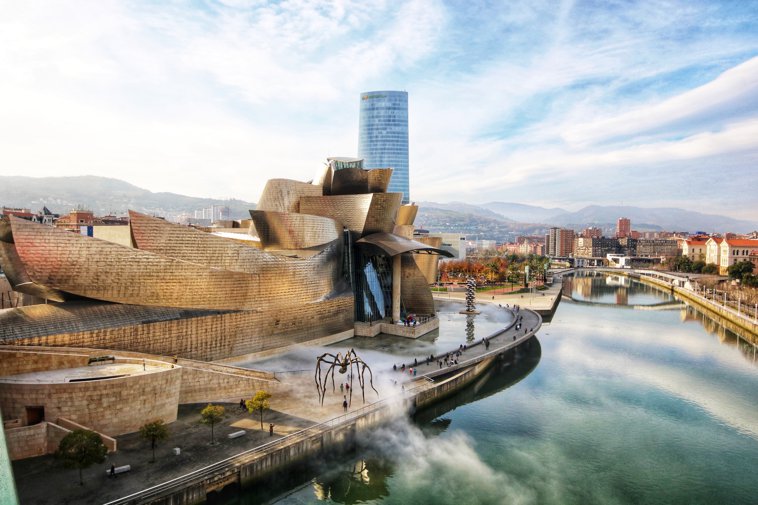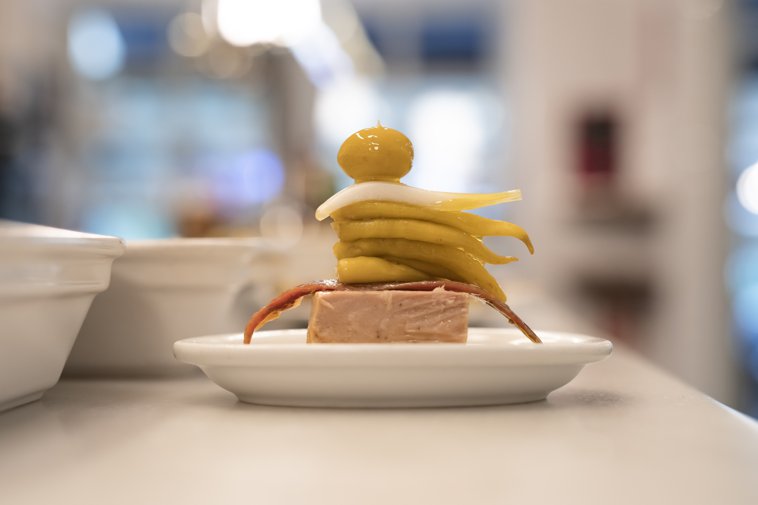Travel Guide: Bilbao, Spain
Questions This Article Answers
What museums should I visit in Bilbao?
Where's the Guggenheim in Bilbao?
What should I eat in Bilbao?
What are the top ten things to see in Bilbao?
What are pintxos?
Bilbao: A Cultural Powerhouse

Art in Bilbao
Perched on the banks of the río Nervión(Nervion River), the Guggenheimis considered by many to be the jewel of Bilbao. Drawing tourists from all over the world, this museum has become a cultural hub in the city. The Guggenheim opened in 1997 and, arguably, sparked the city’s renaissance. As heavy industry died, tourism grew, and the city transformed.
However, the Guggenheim is not the only place to see art in the city. Just down the way from the Guggenheim, you can find the Museo de Bellas Artes de Bilbao(Bilbao Fine Arts Museum). While it’s often overshadowed by its much larger neighbor, this museum of fine arts houses impressive works by both local and international artists.
Architecture in Bilbao
While the Guggenheim is one of Bilbao’s most beloved architectural joyas(jewels), it’s not the only one. The Zubizuri(Basque for white bridge) was designed by Santiago Calatrava, the same architect who designed the The World Trade Center Transportation Hub in New York City. Other must-see buildings in the city include the Palacio Euskalduna(Euskalduna Conference Centre) and the Ayuntamiento de Bilbao(Bilbao City Hall).
Bilbao: A Paradise for Foodies

In spite of being often overshadowed by nearby San Sebastian, Bilbao is sure to please even the most exigente(demanding) foodies.
Bars throughout the city are bursting with pintxos(hors d'oeuvres). Pinchos are typically eaten before lunch, and accompanied by something to drink. Depending on the bar, they can range from the simple gilda, made up of an aceituna(olive), guindilla(Basque guindilla chili pepper), and an anchoa(cured anchovy fillet) to much more elaborate creations. Don’t be afraid to try pinchos in Bilbao. It’s hard to go wrong!
Anchovies!?! While they may get a bad rap in English-speaking culture, anchovies are a local delicacy in northern Spain. Bilbao is just to the east of Santoña, one of the major anchovy-packing hubs in the world. People take their anchovies seriously here, and if there’s ever been a place to try one, we think northern Spain’s your best bet.
It’s highly unlikely that you’ll see the Spanish word pinchos used anywhere in the Basque Country. It is almost always spelled pintxos.
Soccer in Bilbao: Aupa Athletic Club!
When a soccer team refers to its stadium as la Catedral(the Cathedral), you know soccer is going to be a local religion. And, we can’t talk about Bilbao without talking about the Athletic Club. Yes, a Spanish soccer team has an English name. Why? You see, the club was founded in 1898 by British people living in the Bilbao area, probably due to the multiple factories and mines located in and around the city. The name has stayed the same since the club’s founding.
What’s so special about Athletic? The team is unique in that it only allows Basque-born players to play for them. Historically, this has included children of Basque mothers or fathers, as well as children who have immigrated to the region. While it seems like this locals-only policy would make it difficult for the team to be successful, each year they tend to be among the top teams in the Spanish fútbol(soccer) league!
Bilbao's Industrial Past
Bilbao used to be home to a thriving iron, steel, and shipbuilding industry. Nowadays, heavy industry has all but disappeared. You can still see evidence of the minas de hierro(iron mines) on the nearby hills and mountains. Some factories are still there, but many have been torn down to construct new buildings. The río Nervión, once polluted, is far cleaner than it used to be. In fact, you may see people swim in it, and sea life has returned to the river! If you choose to take a boat tour, you may still be able to see some of the city’s industrial remains.
Top Ten Things to See in Bilbao
Here are our picks for the top-ten things to do in Bilbao !
Visit the Guggenheim and the Museo de Bellas Artes. Dedicate your whole day to art!
Walk around the casco viejo(old town). While the casco viejo can be a bit rough at night, it’s worth exploring during the day! Be sure to pop into a local bar, and try some pinchos.
Stroll through the parque de Doña Casilda(Doña Casilda Park). This beautifully landscaped park is near the downtown area and the río Nervión.
Climb the hill to the Basílica de Begoña(Basilica of Begoña) —or take the elevator! This gorgeous basilica houses the image of the city’s patroness.
Check out the Museo Marítimo(Maritime Museum). The sea has always been important to the Basque Country, making the maritime museum an important stop for anyone who wants to understand the region. Be sure to check out their outside exhibits!
Visit the Mercado de la Ribera(Ribera Market) to check out what authentic mercado shopping is like in what is reportedly the largest covered market in Europe. Once you’ve seen everything, head up to the second floor to have a bite at one of its many bars.
Take the funicular de Artxanda(Artxanda funicular, a cable railway). From the top, you’ll enjoy great views of the city.
Take the metro(subway) to Getxoor Portugaleteand cross the Puente Vizcaya(Vizcaya Bridge), which is also known as the Puente Colgante(Hanging Bridge). You can cross this unique transporter bridge on foot by riding in its gondola. If you’re feeling brave, you can walk across the top part!
Stroll along the Nervión. One of the simplest things you can do is simply walk along the río Nervión. If you’re traveling with children, you’re likely to come across a playground! There’s a particularly interesting playground right next to the Guggenheim, where adults can have a coffee at an outdoor bar that often has música en vivo(live music).
Eat. Bilbao has amazing food, and you don’t necessarily have to go to a Michelin-starred restaurant to try it. Even mom-and-pop restaurants tend to have amazing things on offer.
Got the itch to travel? We don’t blame you! Check out the following articles to get more ideas for your next trip to the Spanish-speaking world:














